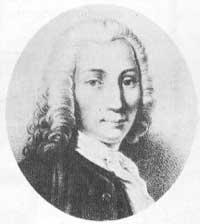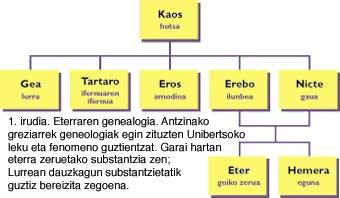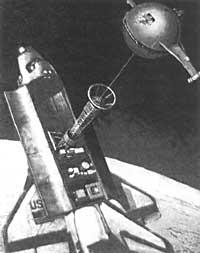Aurora borealis: is there anything more beautiful in the heavenly lands?
1992/12/01 Mujika, Alfontso - Elhuyar Fundazioa Iturria: Elhuyar aldizkaria
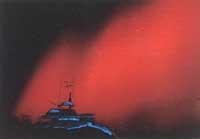
The aurora borealis (also austral) is one of the most spectacular phenomena on our planet. Its exceptional beauty is difficult to describe. You have to see it. Aurora caught the attention of humans in ancient times. His descriptions are found in the Old Testament, in a text by the Roman philosopher Seneca and in medieval European literature. And, of course, in Nordic cultures, we ski them with a rich oral tradition, the Indian Athabasques, the Laponians, the Groenns and the tribes of North Asia have passed down their fables on the aurora from generation to generation.
In these cultures the mysterious lights of heaven, a nearby phenomenon, are deeply rooted. Throughout history, the aurora has sometimes been seen beyond the typical latitudes, frightening the populations of Italy and France. In fact, in the aurora visible from the middle latitudes, the color red is usually a prominent and dominant component, and the European population associated it with blood and battles, as predictors of the accidents and damage that must occur.
Aurora: scientific research
Aurora's research history is long. Pierre Gassendi, XVII. A mathematician and philosopher of the 20th century, he first used the word “aurora” to designate this phenomenon. Aurora, in Roman mythology, was the goddess who opened the doors of heaven to the chariot of the Sun, the announcer of the day.
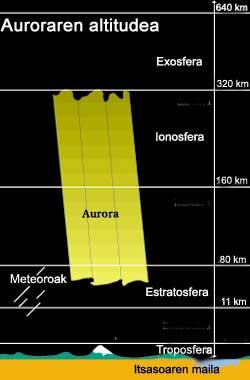
One of the first concerns of scientists was to know the altitude of aurora. Some considered that the aurora originated in the low atmosphere, that is, in the same place where clouds occur. Henry Cavendish (1731-1810) and John Dalton (1766-1844) calculated the aurora at an altitude between 80 and 250 km and the Norwegian physicist Carl Stormer (1874-1957) calculated the altitude accurately. To do this, he made auroras snapshots from two points far away from the song. Later, applying the triangular theory, he calculated that the lowest point of the aurora was 100-105 km from the Earth.
Special attention was also paid to the frequency of the onset of aurora. In 1860, after an exhaustive, long and attentive collection of data, the American Elias Loomis made the first map of auroras. Later, in 1944, E.H. Vestin did another. The data clearly indicate that aurora appears more frequently around a latitude of 65º and that as you move toward higher or lower latitudes, the frequency decreases. At the end of the last century they began to use the photographs to investigate the auroras, but the photograph of the aurora is not so simple. On the one hand, sometimes the movement of the aurora is so fast that not even the current photographic films have been able to record. On the other hand, aurora is a large-scale phenomenon, so you can not properly investigate by taking photos from a single point, but from many points.
The unanswered question in the first half of this century was: when dawn appears, do you see the entire line at the same time or only partly? After the analysis of the photographs, in 1963 it was concluded that the aurora is seen simultaneously through a narrow strip that surrounds the pole and does not coincide with that defined above. This list has been called aurora-obalo. The auroral oval is fixed with respect to the Sun. The Earth takes a full day tour under the auricular oval. Therefore, when turning the Earth, the territory below the atrial oval changes, that is, unlike the atrial area, the auroral oval does not have a fixed geographic location over time. The aurora oval moves inside the aurora, as seen in the rear image with four maps.
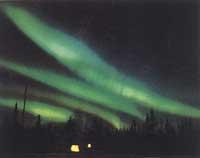
The northern lights and the southern aurora were the same phenomenon. In 1967 a group of researchers was flying over Alaska while another was traveling over New Zealand. The snapshots made by one and the other showed that both auroras were produced simultaneously.
However, the main problem is knowing what type of light the aurora emits. The answer will give us two important data: first, what kind of atoms and molecules light emitters are and, second, why they emit. The scientific section that analyzes it in general is spectroscopy and aurora spectroscopy in our case. The prism is the basic instrument of spectroscopy. Through the prism, light breaks down.
That is the spectrum. XIX. Until the early 20th century, most scientists considered aurora to be a sunlight reflected in the tiny ice crystals suspended in the sky. According to this, the spectrum of aurora light should be equal to that of sunlight. Norwegian physicist Angstrom (1814-74), using the prism, discovered that the aurora spectrum is not continuous, unlike that of sunlight. It features lines and stripes of different colors, with dark areas. The lines are emitted by atoms and bands by molecules (see figure).
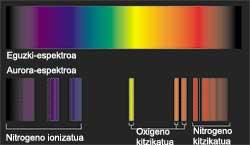
XIX. In the mid-twentieth century scientists knew that a spectrum of light formed by lines and bands could be obtained by introducing a gas into a glass tube and applying a high voltage between the electrodes placed at the ends of the tube. This is the case of neon light. For example, if the neon gas is inserted into a narrow glass tube where the vacuum has been made and connected to a high voltage source, the electrons are poured from the negative to the positive electrode through the tube. These electrons collide with neon atoms and their inner state changes. Atoms are excited. But neon atoms cannot remain excited and return to their initial state. Upon returning to its original state, the energy captured at the time of its excitation is sent to the outside emitting the light: the known red light. But only neon atoms can emit that red light. Scientists analyzed the spectrum emitted by each type of atom and molecule.
In this way the atoms and molecules that generate the spectrum of aurora light have been known. Angstrom discovered in 1868 that the most current aurora light, whitish green, was a green line on the spectrum. However, until 1925 it was not known what was the atom that generated that line, since it was discovered that this green was produced by atomic oxygen (O). In the lower atmosphere there is oxygen, but in molecules (O 2). At the altitude at which aurora appears, oxygen molecules are separated into the oxygen atoms that compose them. In addition, in special conditions, oxygen can also emit dark red light. That is the blood light of the aurora, which terrorized the medieval population.
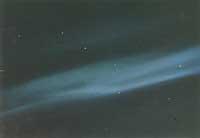
Spectroscopy reveals the mystery of the aurora. Aurora is a discharge phenomenon caused by the entry of energy electrodes into the high polar atmosphere. The altitude atmosphere in which the aurora occurs is similar to that of electronic tubes, that is, the entire upper atmosphere is a giant discharge tube.
Who controls the aurora?
We know that the aurora changes shape, size and color. And sometimes it is much more visible and bright than others. Why? The sun is guilty. If conditions change in the sun, the solar wind changes and this causes changes in the edge of the magnetosphere, where the aurora forms. Today we know that after each of the flames that occur in the Sun the solar wind increases. In addition, we know that the Sun's internal dynamics have an approximate period of 11 years. When periodic solar activity is booming (for example in the years 1957-59, 1968-70, 1979-81 and 1990-92), auroras are more abundant and larger.
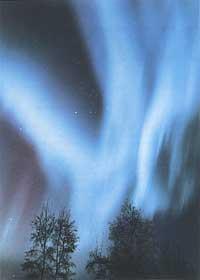
Although they are normally between 350 and 450 km high, when the sun's conditions are special they can reach heights of up to 1,000 km and red. Being so long can be seen from far away. For example, in 1958 a red aurora was seen from Mexico. And earlier, on February 4, 1872, it was seen in Bonbai, in 1909 in Singapore, in 1921 in Samoa. These gigantic red auroras were the ones that made fear in the Middle Ages.
Influence of aurora
Aurora is a discharge phenomenon, that is, it must be taken into account that along the fabric of aurora, in the ionosphere, at an altitude of approximately 100 km, flows an electric current of the order of a million amps. This current produces geo-magnetic interference. For example, it can cause a change of up to 10º in the compass. Moreover, due to the variability of the intensity of this current, the associated variable magnetic field produces electrical currents in long conductors located on Earth, such as electrical power distribution lines, telegraphic lines, pipelines and gas pipelines. It has also caused damage: deterioration of transformers, cutting of communications cables, etc.
Aurora is a complex phenomenon, but to enjoy the beauty of the aurora there is no need to know physics. Just go to the Lamb and look to heaven at night.
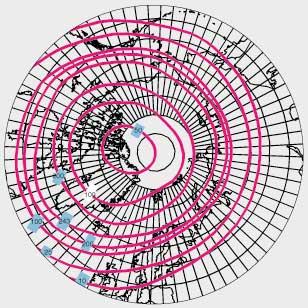
In the attached image E. You can see the map made by the American Harry Vestine in 1944. The number on each curve indicates the average number of nights you can see in aurora per year. Around curve number 243 is called auroraldea. However, since aurora depends on solar activity, when it is booming (for example, between 1990 and 93) aurora will appear more frequently than the map indicates. On the other hand, although not seen on the map, the number of the frequency line that crosses Euskal Herria is approximately 0.5. Therefore, in theory, every two years we could see the dawn of Euskal Herria, but for this we need a sky and a night.
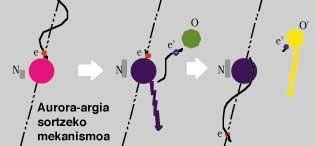
The energy electron (e) is generated in the high atmosphere and collides with nitrogen molecules (N 2). Electrons have so much energy, where they extract an electron (e 1) from the nitrogen molecule. Consequently, the molecule loses a negative charge and becomes positive, that is, it ionizes (N 2). These ionized molecules emit ultraviolet light that the human eye cannot see. The extracted electrons (e 1) also have energy and if on the way they collide with some oxygen atom (O) excite the oxygen atom. When it returns to its initial state, it emits yellow-green light that we see as aurora.
Now we know that the aurora is a gigantic discharge phenomenon that surrounds the Earth. But where is the power generator? The electrical energy associated with aurora discharge is enormous: 10 12 kW<h per year, i.e. 580 times more than the annual electricity consumed throughout the Basque Country.
In any electric generator two elements are necessary: the electric conductor and the magnetic field. When the conductor moves within the magnetic field, an electromotive force is generated in the conductor. In the case of aurora, we can think that the magnetic field is the Earth's magnetic field. And the driver? It is the exterior of the solar atmosphere, known as corona. The temperature in the crown is one million °C, so all its atoms and molecules are ionized, that is, the crown is formed by particles of electric charge.
When the solar wind approaches the Earth a gap forms around the Earth, as the lines of the Earth's magnetic field prevent it. This gap is the magnetosphere. The solar magnetic field, “transported” by the solar wind, is associated with the Earth’s magnetic field. A beam of Earth's magnetic field lines rises above the pole region and disperses into the aforementioned gap, connecting with the magnetic field lines of the solar wind at the edge of the magnetosphere. This is where electricity is generated; when the conductors (winds of the sun) move through the magnetic field. Electricity is generated at the entire edge of the magnetosphere, in the solar generator/magnetosphere. Research has shown that this generator has a voltage of 100,000 volts and an electric power of 1,000,000 MW (250 times the power that would be provided simultaneously by the four nuclear reactors who wanted to settle in Lemoiz and who have not been fortunate).
Every generator needs two terminals. The positive terminal of the Sol-O-Magnetosphere generator is on the “day” of the edge of the magnetosphere (relative to the Sun) and the negative on the “night”. In order to obtain the electric shock from this electric energy generated by this high atmosphere generator, it is necessary to connect this high atmosphere to the terminals and for this purpose “conductors”, “cables” are needed. Where are the cables? Through the highly ionized gas of the magnetosphere, the electric current flows more easily than parallel to the magnetic lines. Therefore, magnetic field lines are invisible “cables”.
As indicated, the Earth's magnetic field lines of the pole region exit the poles and connect with the magnetic field lines of the solar wind. However, only the lines that form the surface of the beam from the beam of lines protruding from the poles (and not those connected to the solar wind lines) are connected to the terminals. Therefore, the electric power of the generator terminals passes from the positive terminal to the high atmosphere of the polar region and is returned from the negative terminal, but only through the surface of the line beam of the polar region. This current consists mainly of electrons. The aurora arises when these electrons collide with atoms and molecules of the high atmosphere.
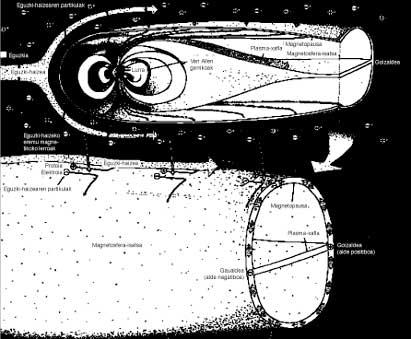
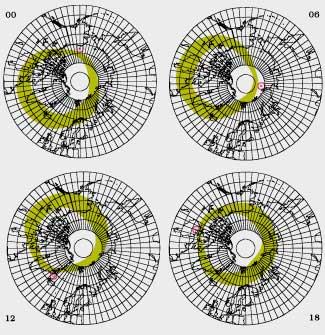
In these images, the auroral oval appears in different places at different times. The position of the Sun is given by the red dot within the circle. As you can see, the largest extension of the aurora oval (that is, of the territory that is seen at the same time the aurora) remains always on the territory that is at midnight.

Gai honi buruzko eduki gehiago
Elhuyarrek garatutako teknologia




